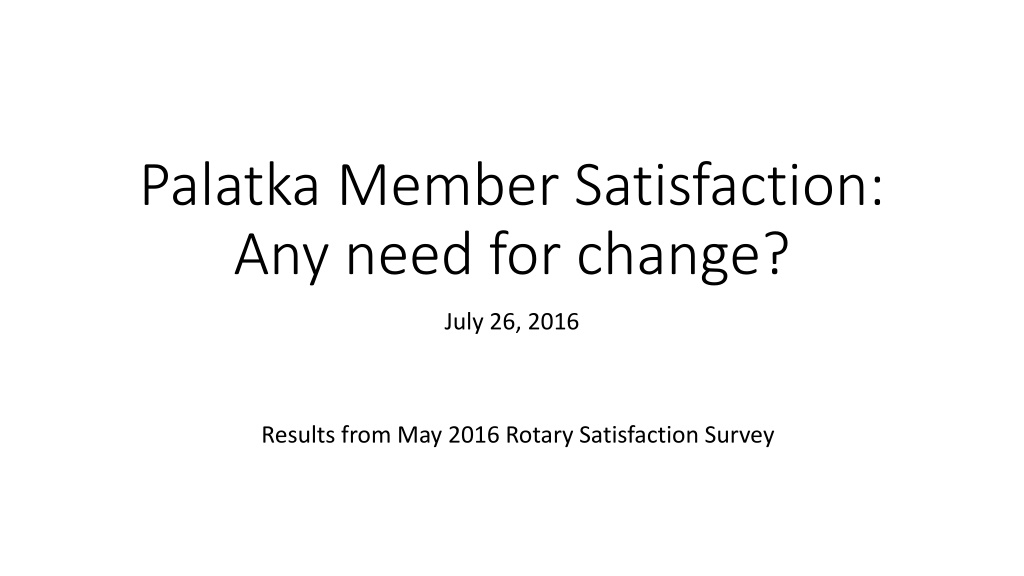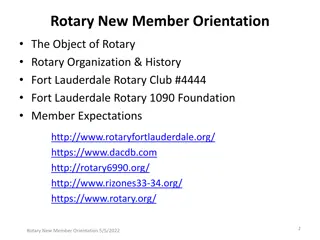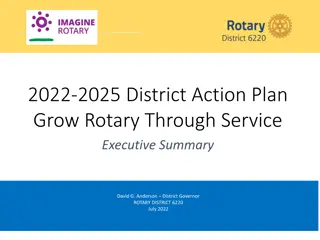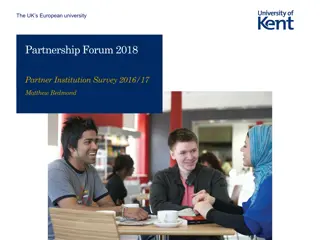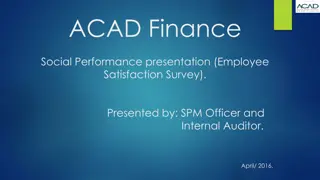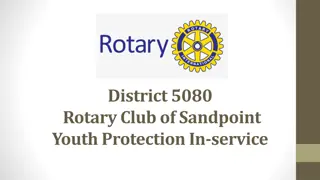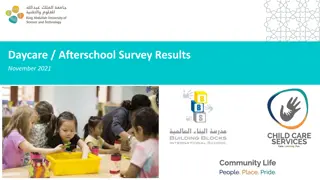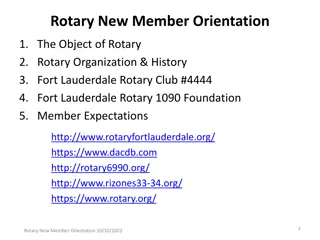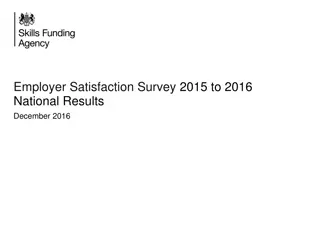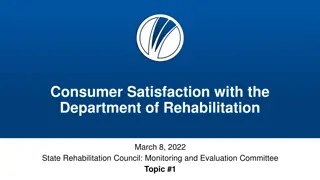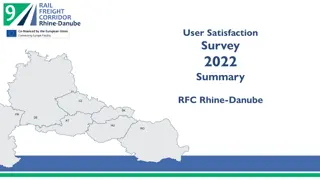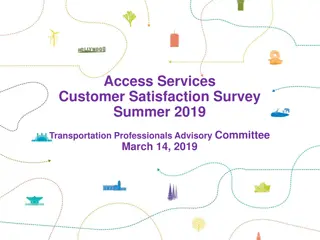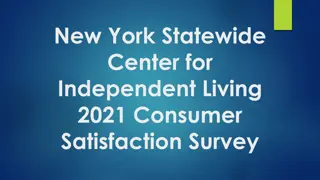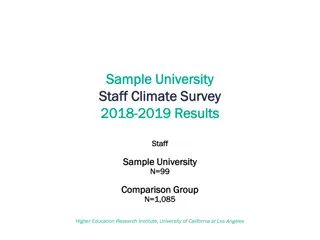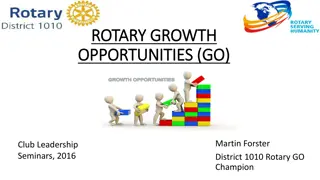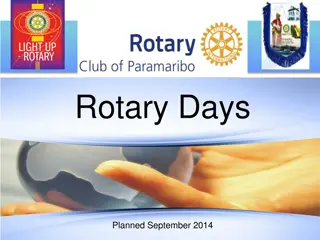Rotary Club Member Satisfaction Survey Results and Insights
Results from the May 2016 Rotary Club satisfaction survey in Palatka reveal that while the response rates were satisfactory, there is a need to attract younger members to ensure future sustainability. The survey highlights a demographic shift towards an older population among current members, prompting a call for engaging Millennials and restructuring organizational practices to align with their preferences for productivity, collaboration, and mentorship. The data emphasizes the importance of adapting to new volunteer engagement trends to foster a more inclusive and active membership base.
Download Presentation

Please find below an Image/Link to download the presentation.
The content on the website is provided AS IS for your information and personal use only. It may not be sold, licensed, or shared on other websites without obtaining consent from the author. Download presentation by click this link. If you encounter any issues during the download, it is possible that the publisher has removed the file from their server.
E N D
Presentation Transcript
Palatka Member Satisfaction: Any need for change? July 26, 2016 Results from May 2016 Rotary Satisfaction Survey
Response Rates were better than expected, but lower than desired A 50% response rate, or above, is desirable to assure that the respondents are representative of the club. 27% of Palatka members responded. (19) Response Rate District Total Palatka 0% 5% 10% 15% 20% 25% 30% 35% 40% 45% 50%
DEMOGRAPHICS OF CLUB DEMOGRAPHICS OF CLUB
About 40% of Palatka Respondents were over 60 Age of Members 35% This group of retiring Baby Boomers is one of the two new sources of volunteers. RI is working to make Rotary more attractive to younger people since we will need replacements. Millennials are the biggest generation now. 30% 25% 20% 15% 10% 5% 0% Palatka Dist% Years of Age <22 22-30 31-40 41-50 51-60 61-70 71+
Volunteering has changed: Lack of Engagement Has Affected ALL Areas Member of Group Baby Boom Gen X Greatest Silent 1900 1970 6 Year of Birth Bowling Alone Study, Putnam, 2000
Fewer people expect to get involved Vote for President Read Newspaper Can trust people Work on community project 1900 1970 Year of Birth
Good News: The Newest Generation Reversed the Trend in Volunteering Millennials (Gen Y) Baby Boomers Gen X 2006 AmeriCorps Study with 2004 Census Data 9
Organizations Will Have to Restructure Since Millennials Want: Focus on Productivity Fewer formal meetings Collaborate; Prefer team approach Use text/facebook/Sharepoint to accomplish tasks with teamwork, but not working at the same time Want mentoring; if not engaged fast, move on Prefer shorter commitments Want full ENGAGEMENT (not token membership) 10/7/2024 10
MEMBERSHIP EFFORTS OF PALATKA MEMBERSHIP EFFORTS OF PALATKA
MEMBER ATTRACTION 80% of the club did NOT sponsor a member last year 80% of the club did NOT sponsor a member last year % of Members Sponsoring New Member 90% 70% invited guests, but only 22% sponsored new members. 80% 70% 60% D6970 Fun Facts: Only one out of four guests becomes a member. Over half of new members are sponsored by 8% of members. One quarter of new members are sponsored by 2% of members! 50% 40% 30% 20% 10% 0% Palatka # of New Members Sponsored by Each Member Grand Total Less RED and more GREEN on chart indicates club attracts more new members 0 1 2 3 4+
So, if you want success attracting new members Think of visitors who are: Interesting at the lunch table; and Passionate about your community. Invite a lot of visitors Have a good team to track your leads and improve your close rate Improve your Fireside so new members know your expectations (and you know their passions) Induct them so they feel special, and the club gets to know them Engage them in their passion immediately
Why People Joined Palatka Rotary. Why People Joined Palatka Rotary . ..and Why They Stay ..and Why They Stay
Why People JOIN Rotary?. "The Primary Reason You JOINED Rotary" Palatka members tend to JOIN for: Networking (60%) Local Service (30%) So new members may be looking for these. 70% 60% 50% 40% 30% 20% 10% 0% Networking Fellowship International Service Local Service Palatka District Average
.the Reason Rotarians STAY often changes "Primary Reason you STAY in Rotary" In Palatka, interests change over Rotarians s career: interest in Local Service grew from 30% to 50% of Rotarians Fellowship increased from 5% to 25% Networking dropped from 60% to 20% Palatka appears to offer great service opportunities 60% 50% 40% 30% 20% 10% 0% Networking Fellowship International Service Local Service Palatka District Average
CONCLUSION: What does it mean for your club? Your club needs to appeal to a variety of types: New members tend to want Networking. Longer term, members tend to want Service and Fellowship more. Your club members need to hear what RI and D6970 offer: RMB [Rotary Means Business] for Networking; District and Global Grants for Service. AND your club will eventually have to change to attract Millennials (there are now more Millennials than Baby Boomers)
SURVEY: MEMBER SATISFACTION Can Palatka change so more members are VERY satisfied? Do Palatka Rotarians look this?: Satisfied Or like this?: VERY Satisfied
What do Satisfied Rotarians FEEL? Rotarians who are HIGHLY Satisfied with their club: 99% plan to stay 2+ years 92% feel strongly welcomed by their club 88% feel strongly that they are encouraged to participate 87% feel strongly that service is effective
Heres how your club compares to D6970: D6970 Averages 59% Very Satisfied 100% 90% 37% 80% 59% 70% 60% 50% 40% 30% 20% 10% 0% Palatka District Average %HiDissatisfied %Dissatisfied %Satisfied %HiSatisfied More Green is good; Red is bad
How does your club feel? 63% Feel Very Encouraged to Participate 74% Feel Very Welcome 100% 100% 90% 90% 80% 80% 70% 70% 63% 72% 74% 77% 60% 60% 50% 50% 40% 40% 30% 30% 20% 20% 10% 10% 0% 0% Palatka Grand Total Palatka District Average %StrongDisagree %Disagree %Agree %StrongAgree %StrongDisagree %Disagree %Agree %StrongAgree
53% Feel Leadership Listens Well 58% Feel Service Very Effective 100% 100% 90% 90% 80% 80% 53% 70% 60% 58% 70% 68% 60% 60% 50% 50% 40% 40% 30% 30% 20% 20% 10% 10% 0% 0% Palatka Grand Total Palatka Grand Total %StrongDisagree %Disagree %Agree %StrongAgree %StrongDisagree %Disagree %Agree %StrongAgree 58% Feel Very Well Informed 100% 90% 80% 58% 70% 65% 60% 50% 40% 30% 20% 10% 0% Palatka Grand Total %StrongDisagree %Disagree %Agree %StrongAgree
SURVEY: STRENGTHS AND WEAKNESSES How to view Strengths and Weaknesses Remember: Building on strengths has more impact than minimizing weakness. You may need to emphasize different areas: Newer Rotarians strong networking. Longer term Rotarians strong service and fellowship. But, if you want to attract new members while keeping the existing ones, you probably want strong networking, service AND fellowship.
STRENGTHS/WEAKNESSES Strengths are listed, in order, based on ratings from Highly Strengths are listed, in order, based on ratings from Highly- - Satisfied members. Satisfied members. Strength? The Club's Reputation in the Community Strength? The Club Members' Overall Commitment to Service 100% 100% 90% 90% 80% 80% 46% 53% 70% 58% 70% 68% SERVICE: Does Palatka DO rather than GIVE? 60% 60% 50% 50% 40% 40% 30% 30% 20% 20% 10% 10% 0% 0% Palatka Rating (1=Major Weakness; 5=Major Strength Dist Avg Palatka Rating (1=Major Weakness; 5=Major Strength Dist Avg 1 2 3 4 5 1 2 3 4 5
STRENGTHS/WEAKNESSES Strength? The Effectiveness of the Club's Charitable Giving Programs Strength? The Club's Ability to Raise Funds for Charitable Giving 100% 100% 90% 90% 37% 37% 80% 80% 49% 51% 70% 70% 60% 60% Giving Giving 50% 50% 40% 40% 30% 30% 20% 20% 10% 10% 0% 0% Palatka Rating (1=Major Weakness; 5=Major Strength Dist Avg Palatka Rating (1=Major Weakness; 5=Major Strength Dist Avg 1 2 3 4 5 1 2 3 4 5 Note: Clubs oriented toward performing service may not rate fund-raising as a strength.
STRENGTHS/WEAKNESSES Strength? The Club's Overall Atmosphere of Welcoming Members Strength? The Club's Ability to Promote Fellowship Among its Members. 100% 100% 90% 90% 37% 80% 42% 80% 42% 51% 70% 70% 60% 60% 50% 50% 40% 40% 30% 30% 20% 20% 10% 10% 0% 0% Palatka Rating (1=Major Weakness; 5=Major Strength Dist Avg Palatka Rating (1=Major Weakness; 5=Major Strength Dist Avg 1 2 3 4 5 1 2 3 4 5
CONCLUSION: What to do now? See where your club s strengths are. Build on the strengths of your club first; great organizations aren t built by minimizing weakness. Examine weaknesses that could seriously affect your club: Age? Welcoming? Fellowship? Team approaches build better commitment to change. Multi-year plans are most effective to achieve enduring change. Ask help from the District or Zone, if you want ideas or help.
Questions? Give us a call if we can help: District Membership Co-Chairs Mike Darragh mikehdarragh@gmail.com Russ Miller - pdgruss@lazyscape.com Your Assistant or Area Governors Zone Rotary Coordinator team - art.macqueen13.14@gmail.com
